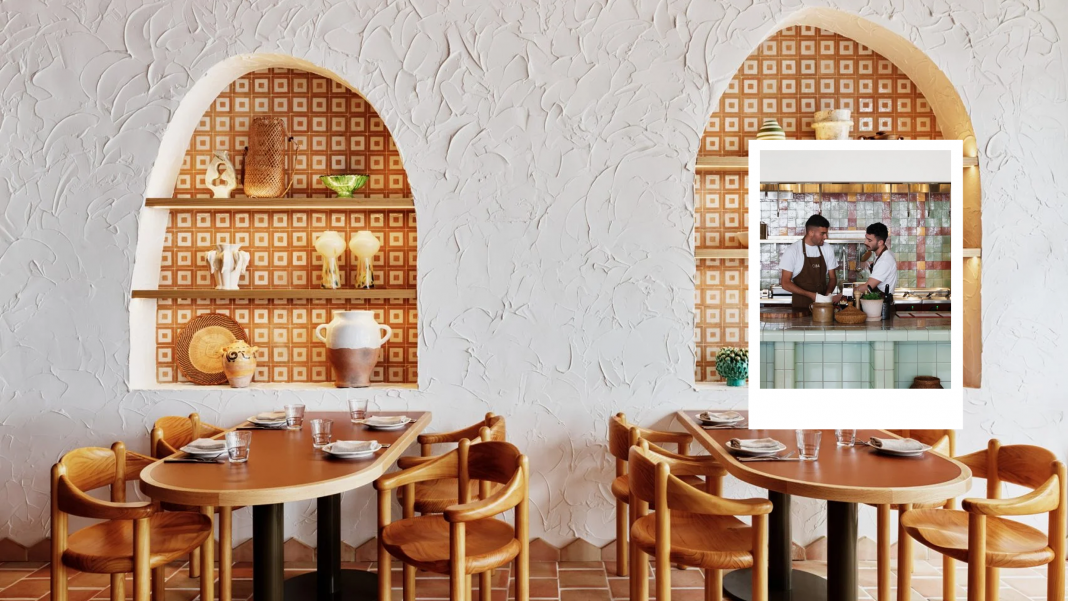At the intersection of coastal calm and Mediterranean romance, Cibaria, a new all-day restaurant in Sydney’s Manly Pacific Hotel, is a sensory celebration. Designed by local studio Luchetti Krelle, the interiors playfully merge asymmetry with artisanal craftsmanship, conjuring the rustic elegance of southern Europe through textural contrasts, arched niches, and patterned tiles—all against the backdrop of sweeping sea views.

An ode to Puglian farmhouses and Mediterranean charm
Drawing direct inspiration from the masserias of Puglia—historic rural farmhouses that have been transformed into boutique hotels—Cibaria pays homage to the layered traditions of Mediterranean design. “We were inspired by masseria in Puglia… offering glimpses into rural traditions,” said Luchetti Krelle, whose wider renovation of the Manly Pacific Hotel set the tone for this ground-floor dining destination.
Guests arrive through timber-framed glass doors accessed via the hotel lobby, stepping into a 630-square-meter interior where coastal openness meets grounded texture. Key to the transformation was raising the formerly low ceiling, now revealing generous volume and expansive sashless windows that flood the restaurant with natural light and direct views of Manly Beach.
The resulting ambiance is one of sun-drenched informality—layered with complexity and punctuated by sculptural moments, such as carved arches and niches reminiscent of Jacques Couëlle’s surrealist Cala di Volpe hotel in Sardinia. These stuccoed white curves frame interior thresholds, lending a sense of discovery throughout the space.
A tactile tapestry of timber, tile, and texture
Cibaria is zoned into several distinct areas, each with its own palette yet unified by a consistent material rhythm. From curved banquettes and open kitchens to intimate private dining rooms, the space was conceived to be modular yet cohesive. Timber plays a central role in softening the raw Mediterranean undertones—fluted timber panelling defines the maître d’ stand and banquette bases, while rustic timber beams add a timeworn charm that deepens the atmosphere.
Above the dining area, a slatted timber bulkhead conceals mechanical systems, striking a balance between design and utility. Throughout, patterned tile flooring marks transitions between spaces: terracotta pavers, checkerboard mosaics, and pistachio-hued terrazzo offer visual segmentation while reinforcing the Mediterranean vernacular.
The playful use of color is also prominent, with red and white stripes appearing on everything from curved banquettes to cornices in private rooms and external awnings. “These stripes reference the Italian flag, given the modern Mediterranean menu, and also Venetian mooring poles,” the designers explained.

Grotto-like niches and gastronomic vignettes
One of Cibaria’s signature elements is its grotto-inspired wall niches and archways—sculptural recesses carved from white stucco that act as both functional and aesthetic anchors. A trio of archways frames a golden wine cabinet, offering a shrine-like presence at the heart of the dining room. These niches add rhythm and a sense of visual narrative to the restaurant, echoing natural erosion or the hand-sculpted interiors of coastal dwellings.
Further enhancing this sensory journey is the integration of varied textiles and printed fabrics. From checkerboard ceiling panels to striped upholstery and graphic tiles, the space feels curated yet spontaneous. It’s a material collage that never overwhelms—a thoughtful layering that invites exploration.
Even the bathrooms extend the narrative. Here, dusty pink terracotta walls frame a freestanding vanity carved from a single block of silver travertine—its organic arch silhouette resonating with the restaurant’s architectural vocabulary. Burgundy skirting boards continue the red-and-white motif, anchoring the visual experience from entry to exit.

Seamless transitions between leisure and indulgence
Cibaria’s design doesn’t stop at formal dining. A casual offshoot in the form of a seaside ice cream shop occupies a corner entrance, catering to beachgoers with sandy feet. This area features lighter terrazzo flooring to disguise footprints and reflects the restaurant’s commitment to practical beauty. It’s a gentle nod to the Mediterranean café culture, where casual snacking and gourmet meals exist in easy proximity.
Meanwhile, a more refined dining room overlooking the ocean invites longer, more immersive culinary experiences. Tables with expansive sea views are surrounded by elegant terracotta pavers and soft banquette seating, allowing the material story to support the menu’s emphasis on fresh, seasonal Mediterranean fare. “The design blends nostalgia with a modern sensibility,” said Luchetti Krelle. And indeed, Cibaria achieves a delicate balance: rooted in heritage but never weighed down by it, bold yet serene, traditional but undeniably contemporary.
A growing portfolio of layered storytelling
Cibaria is the latest in a string of visually expressive projects by Luchetti Krelle, whose portfolio includes a seafood restaurant defined by playful, oceanic motifs and a 1970s-inspired bar set in a former butcher shop. Across all of their work, the studio leans into dramatic materials and bold palettes without losing sight of intimacy or functionality.
With Cibaria, they’ve demonstrated a mastery of spatial storytelling—transforming a hotel restaurant into a transportive destination. It’s a reminder that design, when thoughtful and textured, can not only evoke place but reshape our perception of it. As Sydney’s dining scene becomes ever more competitive, Cibaria carves its niche—quite literally—with arches, stripes and timeless southern soul.



